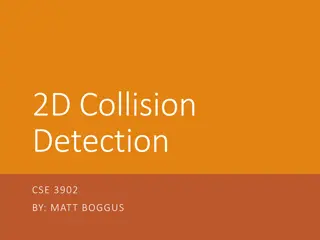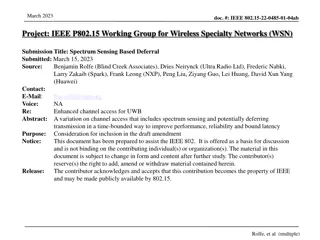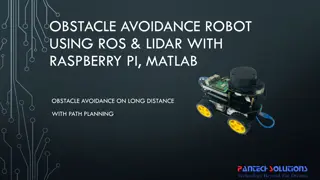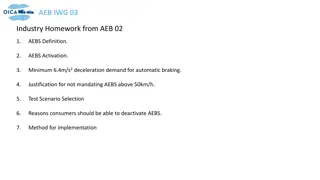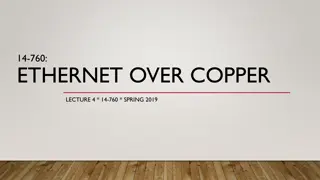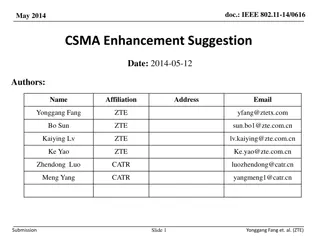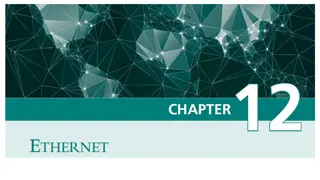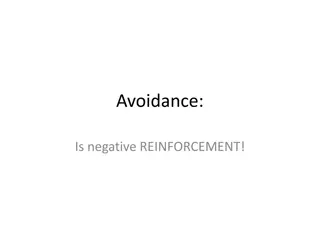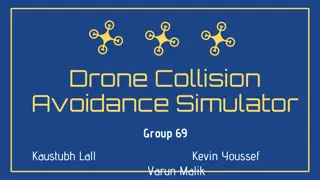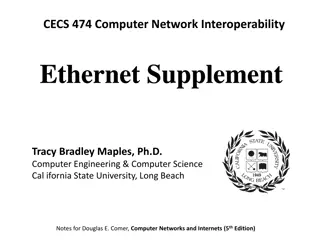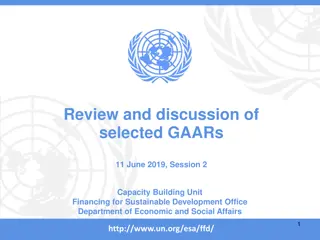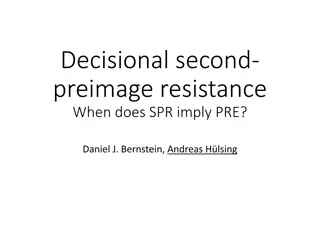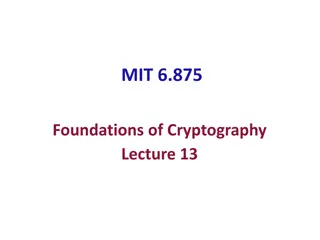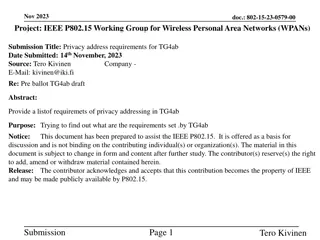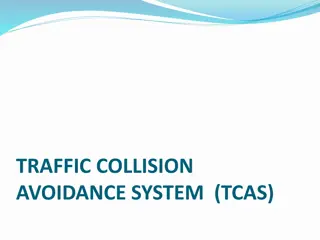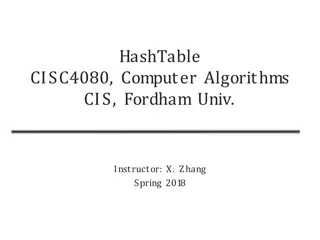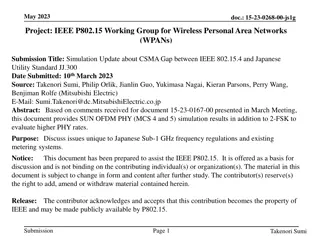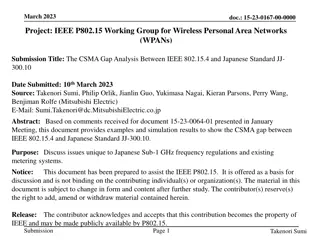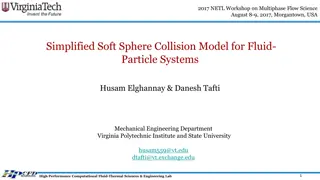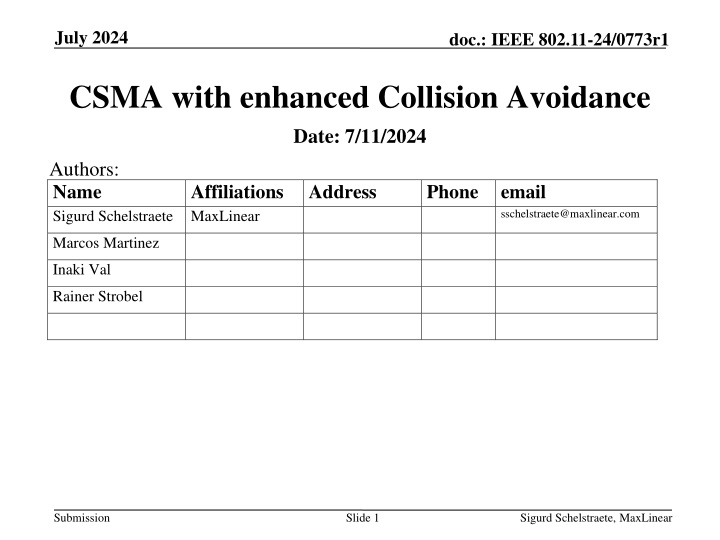
Enhancing Collision Avoidance in CSMA Networks
Investigating modifications to improve collision avoidance in CSMA networks by enhancing random backoff and adaptive contention window mechanisms. The proposal suggests introducing a new collision avoidance phase to resolve collisions effectively without relying on MAC mechanisms. Addressing the issue of collisions resulting from a too short contention window in highly congested networks.
Download Presentation

Please find below an Image/Link to download the presentation.
The content on the website is provided AS IS for your information and personal use only. It may not be sold, licensed, or shared on other websites without obtaining consent from the author. If you encounter any issues during the download, it is possible that the publisher has removed the file from their server.
You are allowed to download the files provided on this website for personal or commercial use, subject to the condition that they are used lawfully. All files are the property of their respective owners.
The content on the website is provided AS IS for your information and personal use only. It may not be sold, licensed, or shared on other websites without obtaining consent from the author.
E N D
Presentation Transcript
July 2024 doc.: IEEE 802.11-24/0773r1 CSMA with enhanced Collision Avoidance Date: 7/11/2024 Authors: Name Sigurd Schelstraete MaxLinear Affiliations Address Phone email sschelstraete@maxlinear.com Marcos Martinez Inaki Val Rainer Strobel Submission Slide 1 Sigurd Schelstraete, MaxLinear
July 2024 doc.: IEEE 802.11-24/0773r1 Introduction A previous submission [1] looked at collisions in CSMA/CA For highly congested networks, collisions have a significant impact on performance This submission investigates modifications to enhance the inherent collision avoidance of CSMA i.e., without reliance on MAC mechanisms Submission Slide 2 Sigurd Schelstraete, MaxLinear
July 2024 doc.: IEEE 802.11-24/0773r1 Collisions in CSMA/CA Collisions in CSMA/CA are mitigated by random backoff and adaptive Contention Window (CW) designed to reduce the collision probability Collision probability increases with increasing number of contending STAs see [1] Submission Slide 3 Sigurd Schelstraete, MaxLinear
July 2024 doc.: IEEE 802.11-24/0773r1 Addressing Collisions in CSMA The cause of collisions is a too short CW for the number of contending STAs Not enough distinct random values Note: not considering hidden nodes in this submission When a collision happens, the number of colliding devices is statically much lower than the total number of contending devices Main idea: Additional contention between those surviving STAs may be able to resolve the collision Submission Slide 4 Sigurd Schelstraete, MaxLinear
July 2024 doc.: IEEE 802.11-24/0773r1 Collision Illustration Submission Slide 5 Sigurd Schelstraete, MaxLinear
July 2024 doc.: IEEE 802.11-24/0773r1 Proposal Introduce a new collision avoidance phase after the transmitter gains access to the medium In a way that is compatible with CSMA Send frame uponreaching end of backoff AIFS Traditional CSMA Perform short back-off (BO') < AIFS[VO]. End contention if CCA high before end of BO'. Perform CSMA CW back-off (BO). End contention if CCA high before end of BO. AIFS New Proposal Send actual frame upon reaching end of last backoff Send short signalupon reaching end of backoff Repeat N times Submission Slide 6 Sigurd Schelstraete, MaxLinear
July 2024 doc.: IEEE 802.11-24/0773r1 Details STAs perform CSMA to gain access to the medium Any STA that gains access (there could be more than one) transmits only a short signal (e.g., L-STF) sufficient for other STAs that are still contending to understand that the medium is busy (PD) Surviving STAs (i.e. STAs that were able to complete the backoff) perform multiple short backoff rounds Shorter than AIFS[VO] such that no other STA can gain access Any STA that reaches the end of its backoff counter will again only send a short signal Any STA that observes a busy medium prior to reaching the end of the countdown will abandon its attempt to access the medium After the last short contention , STA can transmit Submission Slide 7 Sigurd Schelstraete, MaxLinear
July 2024 doc.: IEEE 802.11-24/0773r1 Collision resolution illustration Submission Slide 8 Sigurd Schelstraete, MaxLinear
July 2024 doc.: IEEE 802.11-24/0773r1 Notes Note that none of the STAs knows whether there is more than one STA that gained access to the medium Not a requirement Each STA only knows that it was able to reach the end of its backoff counter without observing a busy medium Number of rounds is fixed but can be tuned to achieve a desired collision probability First slot after transmission of short signal is used for Tx/Rx turnaround No transmissions in this slot The probability of collisions is reduced exponentially There remains a non-zero (but significantly reduced) chance that multiple STAs will be in a tie during all short backoff rounds. Submission Slide 9 Sigurd Schelstraete, MaxLinear
July 2024 doc.: IEEE 802.11-24/0773r1 Simulations Network simulation to assess performance 1 AP, N STAs with full-buffer uplink traffic N: 1, 2, 5, 10, 20 Link: MCS 7, 1SS Collisions are assumed to lead to loss of the packet Submission Slide 10 Sigurd Schelstraete, MaxLinear
July 2024 doc.: IEEE 802.11-24/0773r1 How many short contentions are needed? More iterations improve collisions, but add some (time) overhead Optimal number depends on network load 3-4 rounds looks appropriate considering all ACs and a wide range of network conditions Submission Slide 11 Sigurd Schelstraete, MaxLinear
July 2024 doc.: IEEE 802.11-24/0773r1 Throughput results Significant improvement over CSMA (dashed curves see [1]) 4 rounds makes network throughput virtually independent of number of contending STAs Slide 12 Submission Sigurd Schelstraete, MaxLinear
July 2024 doc.: IEEE 802.11-24/0773r1 Collision percentages Collisions virtually eliminated with 4 iterations Submission Slide 13 Sigurd Schelstraete, MaxLinear
July 2024 doc.: IEEE 802.11-24/0773r1 Visualization Visual representation of simulation runs: Results for CSMA and enhanced CSMA for N=20 STAs, AC_BE, 4 iterations Submission Slide 14 Sigurd Schelstraete, MaxLinear
July 2024 doc.: IEEE 802.11-24/0773r1 Backwards compatibility with legacy Method is by design compatible with existing CSMA/CA No unfair advantage in gaining access to the medium New systems may be friendlier in collision than other legacy system Submission Slide 15 Sigurd Schelstraete, MaxLinear
July 2024 doc.: IEEE 802.11-24/0773r1 Other proposals Other proposals [2, 3, 4] have attempted to address the collision issue in other ways Similar concepts appear in some of these other proposals Contention among reduced set of STAs [2] Short reservation signal [2, 4] Submission Slide 16 Sigurd Schelstraete, MaxLinear
July 2024 doc.: IEEE 802.11-24/0773r1 Conclusions We have presented a modified CSMA/CA method with enhanced collision avoidance Compatible with existing CSMA/CA The method significantly reduces the probability of collision in a highly congested environment We propose that concepts introduced here be further explored Possible common ground with other proposals [2, 4] Submission Slide 17 Sigurd Schelstraete, MaxLinear
July 2024 doc.: IEEE 802.11-24/0773r1 References [1] CSMA Collision analysis , IEEE 802.11-23/0772 [2] Low latency channel access, IEEE 802.11-23/1065 [3] Deterministic Backoff, IEEE 802.11-24/0031 [4] Ultra-reliable PHY elements: Low latency, low collision, low power medium access, IEEE 802.11-24/0284 Submission Slide 18 Sigurd Schelstraete, MaxLinear


